Assessment Types in Education: A Comprehensive Report
VerifiedAdded on 2020/03/16
|8
|1614
|44
Report
AI Summary
This report provides a comprehensive overview of various assessment types utilized in educational settings. It delves into the significance of initial, diagnostic, and formative assessments, highlighting their distinct purposes and applications. The report examines how these assessment methods contribute to understanding student capabilities, identifying learning gaps, and improving teaching strategies. It explores the practical implementation of these assessments, including examples from cross-cultural classrooms and strategies for addressing student needs. Furthermore, the report emphasizes the importance of selecting appropriate assessment methods to achieve desired learning outcomes, ensuring that each method serves its intended purpose effectively. The report also includes a detailed discussion of how initial assessments help in identifying the baseline knowledge of students, diagnostic assessments help in identifying the skills and abilities of the students, and formative assessments help in tracking the progress of the students during the learning process. The report concludes by underscoring the value of these assessment types in enhancing the overall learning experience and fostering student success.
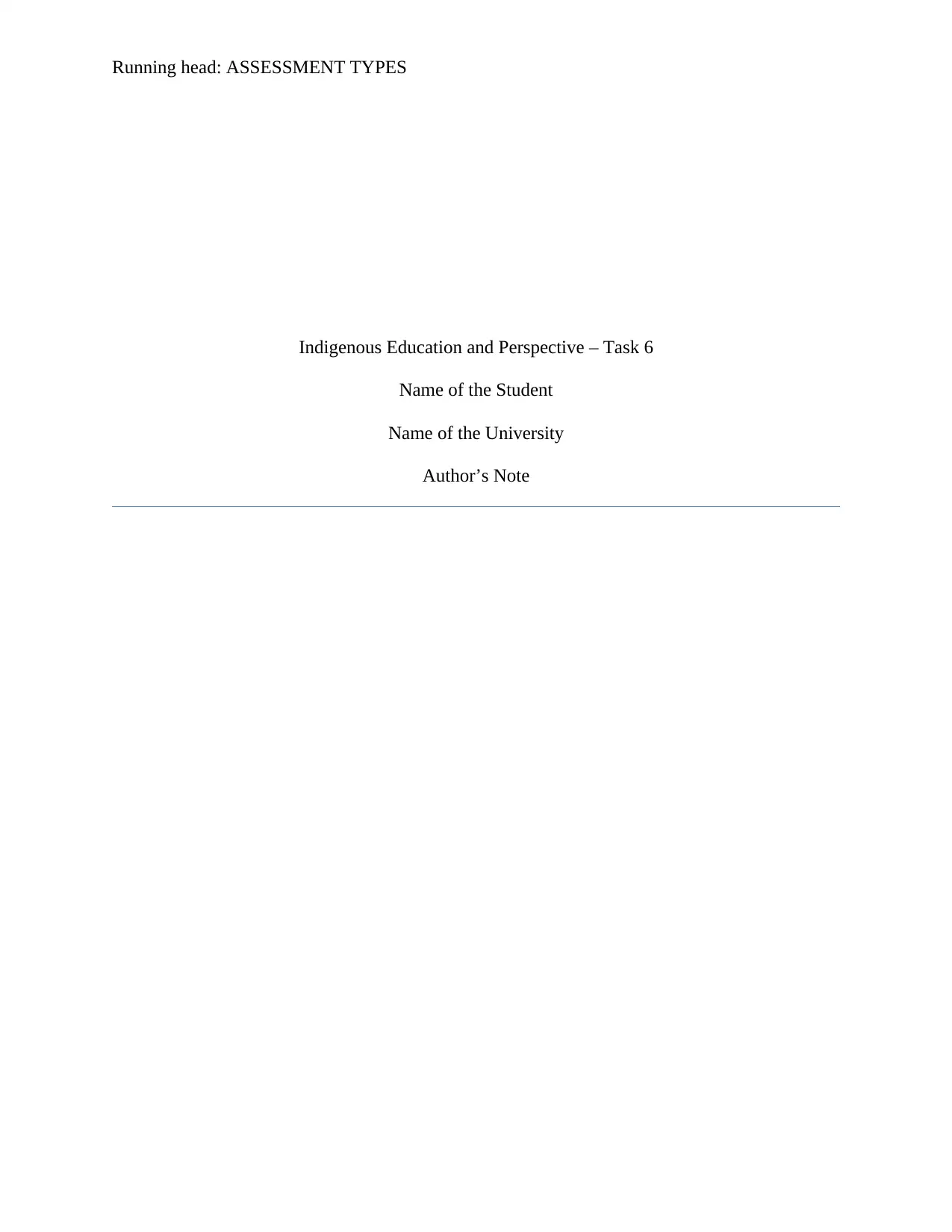
Running head: ASSESSMENT TYPES
Indigenous Education and Perspective – Task 6
Name of the Student
Name of the University
Author’s Note
Indigenous Education and Perspective – Task 6
Name of the Student
Name of the University
Author’s Note
Paraphrase This Document
Need a fresh take? Get an instant paraphrase of this document with our AI Paraphraser
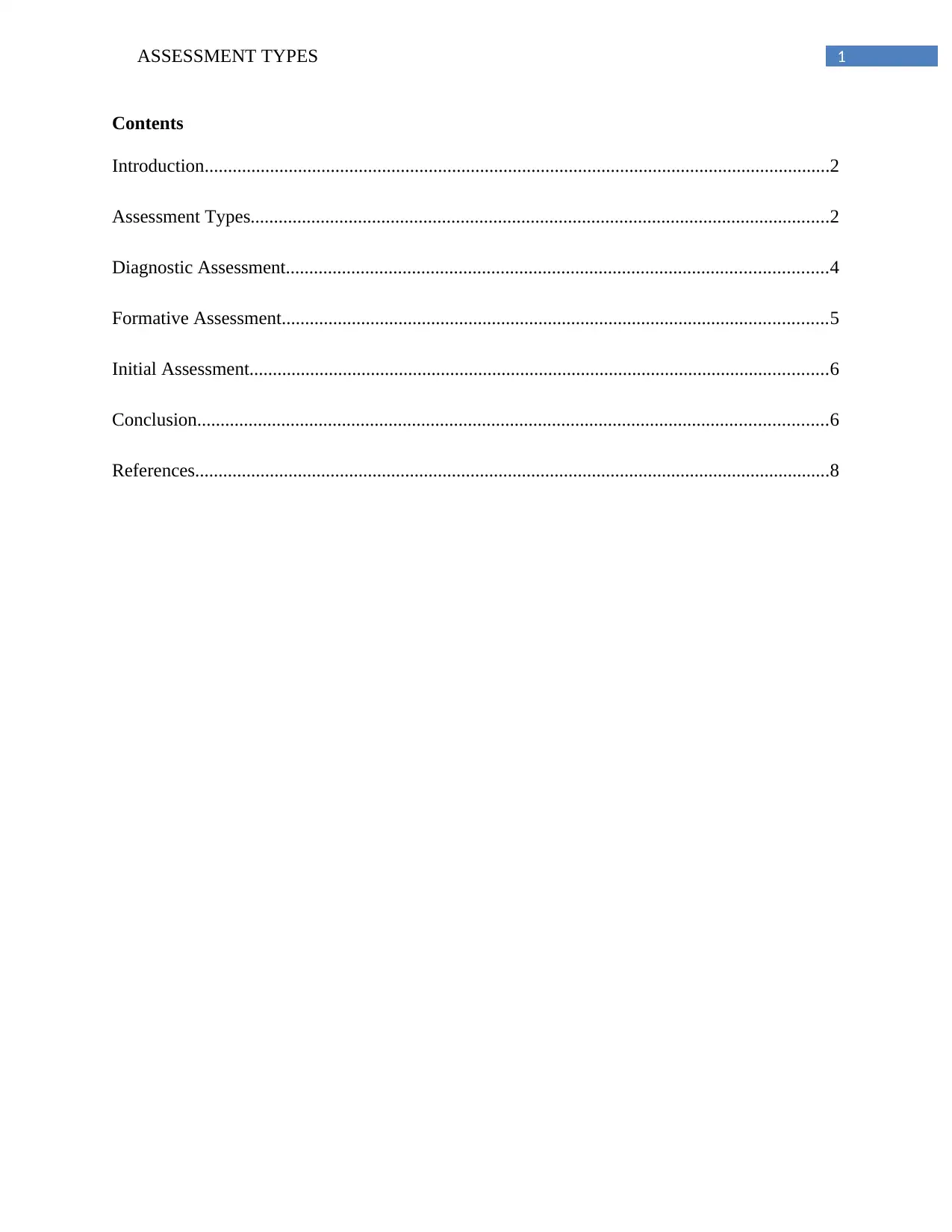
1ASSESSMENT TYPES
Contents
Introduction......................................................................................................................................2
Assessment Types............................................................................................................................2
Diagnostic Assessment....................................................................................................................4
Formative Assessment.....................................................................................................................5
Initial Assessment............................................................................................................................6
Conclusion.......................................................................................................................................6
References........................................................................................................................................8
Contents
Introduction......................................................................................................................................2
Assessment Types............................................................................................................................2
Diagnostic Assessment....................................................................................................................4
Formative Assessment.....................................................................................................................5
Initial Assessment............................................................................................................................6
Conclusion.......................................................................................................................................6
References........................................................................................................................................8
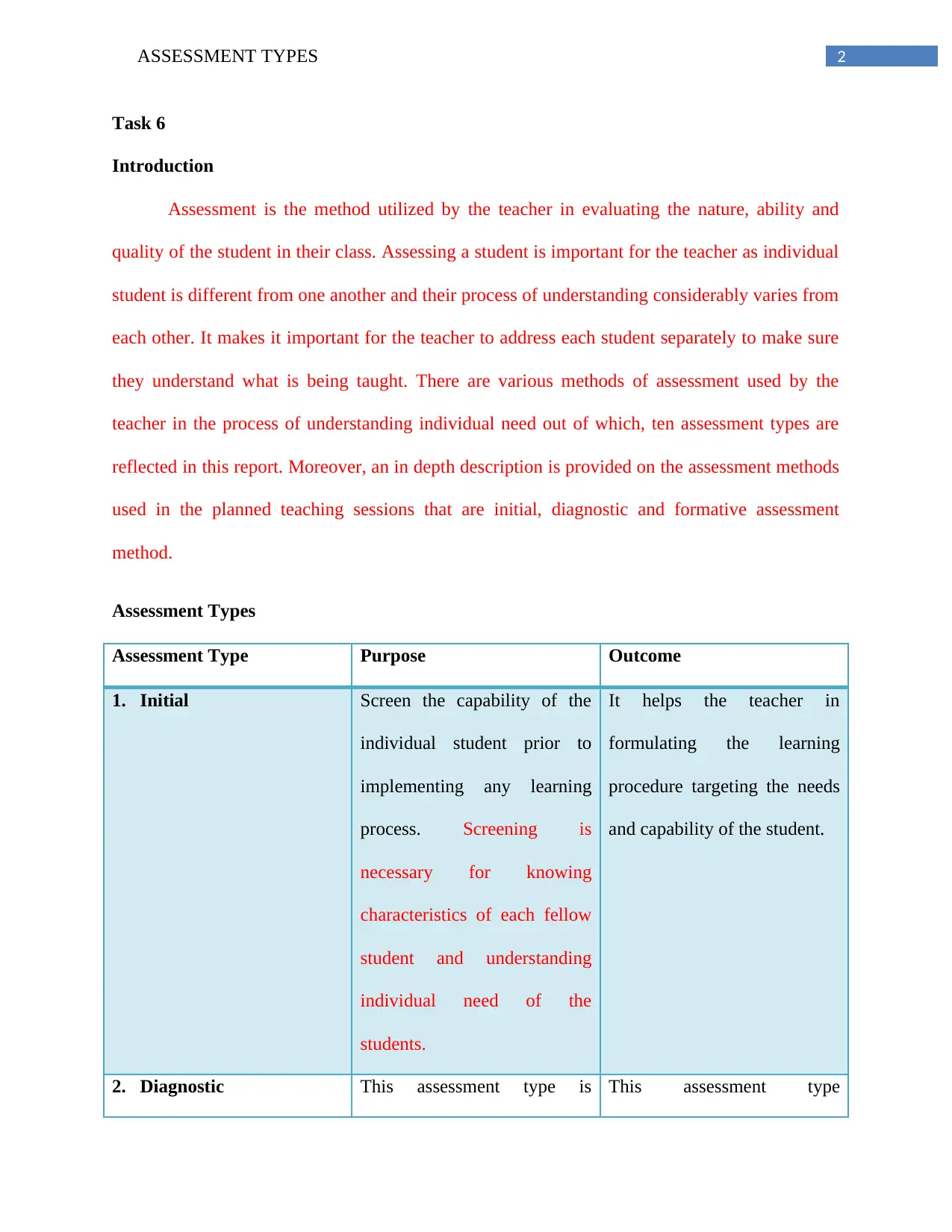
2ASSESSMENT TYPES
Task 6
Introduction
Assessment is the method utilized by the teacher in evaluating the nature, ability and
quality of the student in their class. Assessing a student is important for the teacher as individual
student is different from one another and their process of understanding considerably varies from
each other. It makes it important for the teacher to address each student separately to make sure
they understand what is being taught. There are various methods of assessment used by the
teacher in the process of understanding individual need out of which, ten assessment types are
reflected in this report. Moreover, an in depth description is provided on the assessment methods
used in the planned teaching sessions that are initial, diagnostic and formative assessment
method.
Assessment Types
Assessment Type Purpose Outcome
1. Initial Screen the capability of the
individual student prior to
implementing any learning
process. Screening is
necessary for knowing
characteristics of each fellow
student and understanding
individual need of the
students.
It helps the teacher in
formulating the learning
procedure targeting the needs
and capability of the student.
2. Diagnostic This assessment type is This assessment type
Task 6
Introduction
Assessment is the method utilized by the teacher in evaluating the nature, ability and
quality of the student in their class. Assessing a student is important for the teacher as individual
student is different from one another and their process of understanding considerably varies from
each other. It makes it important for the teacher to address each student separately to make sure
they understand what is being taught. There are various methods of assessment used by the
teacher in the process of understanding individual need out of which, ten assessment types are
reflected in this report. Moreover, an in depth description is provided on the assessment methods
used in the planned teaching sessions that are initial, diagnostic and formative assessment
method.
Assessment Types
Assessment Type Purpose Outcome
1. Initial Screen the capability of the
individual student prior to
implementing any learning
process. Screening is
necessary for knowing
characteristics of each fellow
student and understanding
individual need of the
students.
It helps the teacher in
formulating the learning
procedure targeting the needs
and capability of the student.
2. Diagnostic This assessment type is This assessment type
⊘ This is a preview!⊘
Do you want full access?
Subscribe today to unlock all pages.

Trusted by 1+ million students worldwide

3ASSESSMENT TYPES
competent in identification of
the capabilities, competence,
abilities and disabilities of the
soft skills of the individual. It
also identifies the gap between
the existing and desired skills.
identifies the current situation
and guidance to improve the
quality and accuracy of the
skills.
3. Formal It is the formal evaluation of
the student’s performance.
There can be multiple methods
in formal assessment method
such as class test and viva.
It recognizes student’s overall
performance and growth.
4. Informal To record the progress
attained by the student in the
process of learning. The
process includes the
interaction method in the
classroom during the ongoing
learning session.
It keeps track on the
improvement of the student
during the learning procedure
5. Dynamic The assessment serves the
purpose of understanding the
existing knowledge of a
student.
It helps the teacher in focusing
on the particular need of the
student.
6. Authentic Recognizes both the academic It helps in developing the
competent in identification of
the capabilities, competence,
abilities and disabilities of the
soft skills of the individual. It
also identifies the gap between
the existing and desired skills.
identifies the current situation
and guidance to improve the
quality and accuracy of the
skills.
3. Formal It is the formal evaluation of
the student’s performance.
There can be multiple methods
in formal assessment method
such as class test and viva.
It recognizes student’s overall
performance and growth.
4. Informal To record the progress
attained by the student in the
process of learning. The
process includes the
interaction method in the
classroom during the ongoing
learning session.
It keeps track on the
improvement of the student
during the learning procedure
5. Dynamic The assessment serves the
purpose of understanding the
existing knowledge of a
student.
It helps the teacher in focusing
on the particular need of the
student.
6. Authentic Recognizes both the academic It helps in developing the
Paraphrase This Document
Need a fresh take? Get an instant paraphrase of this document with our AI Paraphraser
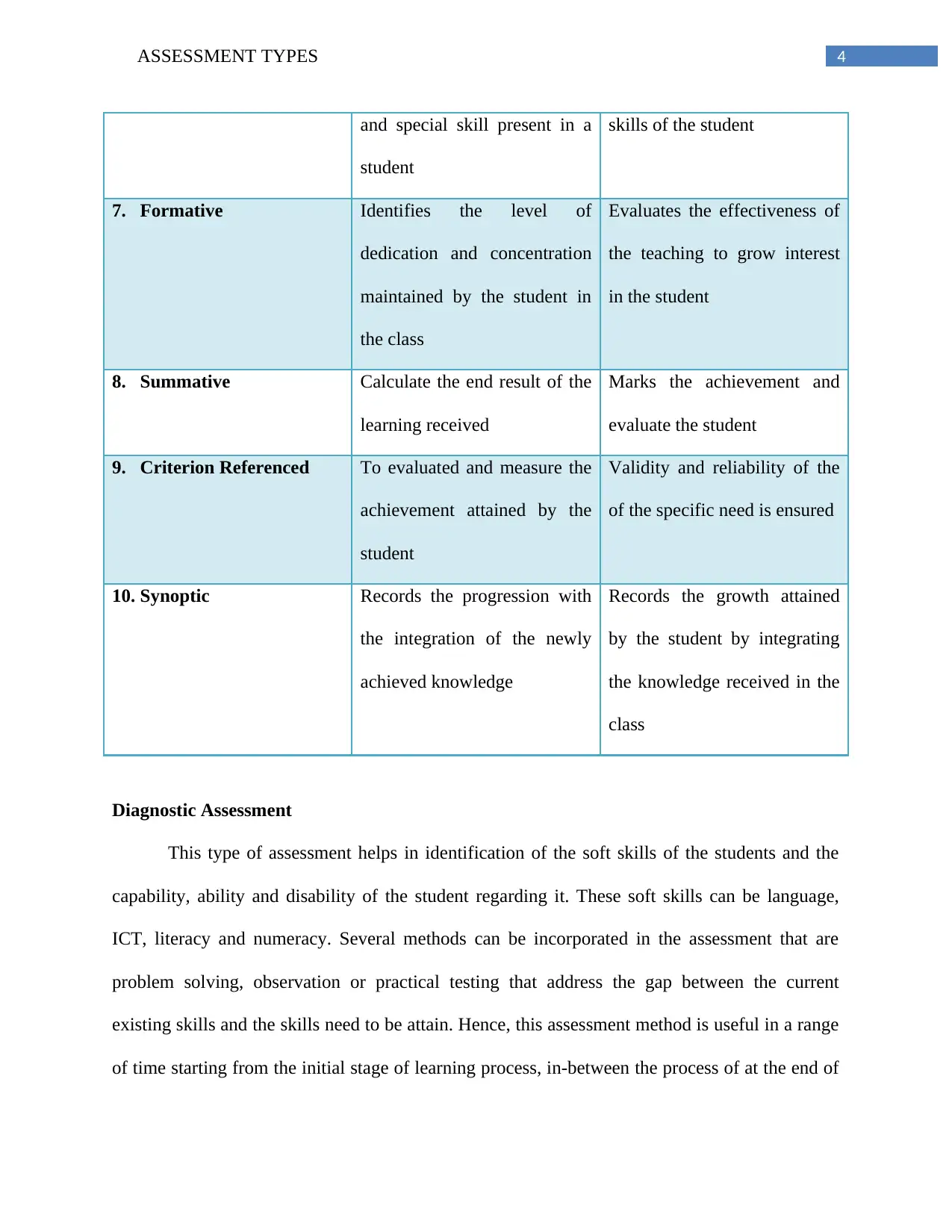
4ASSESSMENT TYPES
and special skill present in a
student
skills of the student
7. Formative Identifies the level of
dedication and concentration
maintained by the student in
the class
Evaluates the effectiveness of
the teaching to grow interest
in the student
8. Summative Calculate the end result of the
learning received
Marks the achievement and
evaluate the student
9. Criterion Referenced To evaluated and measure the
achievement attained by the
student
Validity and reliability of the
of the specific need is ensured
10. Synoptic Records the progression with
the integration of the newly
achieved knowledge
Records the growth attained
by the student by integrating
the knowledge received in the
class
Diagnostic Assessment
This type of assessment helps in identification of the soft skills of the students and the
capability, ability and disability of the student regarding it. These soft skills can be language,
ICT, literacy and numeracy. Several methods can be incorporated in the assessment that are
problem solving, observation or practical testing that address the gap between the current
existing skills and the skills need to be attain. Hence, this assessment method is useful in a range
of time starting from the initial stage of learning process, in-between the process of at the end of
and special skill present in a
student
skills of the student
7. Formative Identifies the level of
dedication and concentration
maintained by the student in
the class
Evaluates the effectiveness of
the teaching to grow interest
in the student
8. Summative Calculate the end result of the
learning received
Marks the achievement and
evaluate the student
9. Criterion Referenced To evaluated and measure the
achievement attained by the
student
Validity and reliability of the
of the specific need is ensured
10. Synoptic Records the progression with
the integration of the newly
achieved knowledge
Records the growth attained
by the student by integrating
the knowledge received in the
class
Diagnostic Assessment
This type of assessment helps in identification of the soft skills of the students and the
capability, ability and disability of the student regarding it. These soft skills can be language,
ICT, literacy and numeracy. Several methods can be incorporated in the assessment that are
problem solving, observation or practical testing that address the gap between the current
existing skills and the skills need to be attain. Hence, this assessment method is useful in a range
of time starting from the initial stage of learning process, in-between the process of at the end of
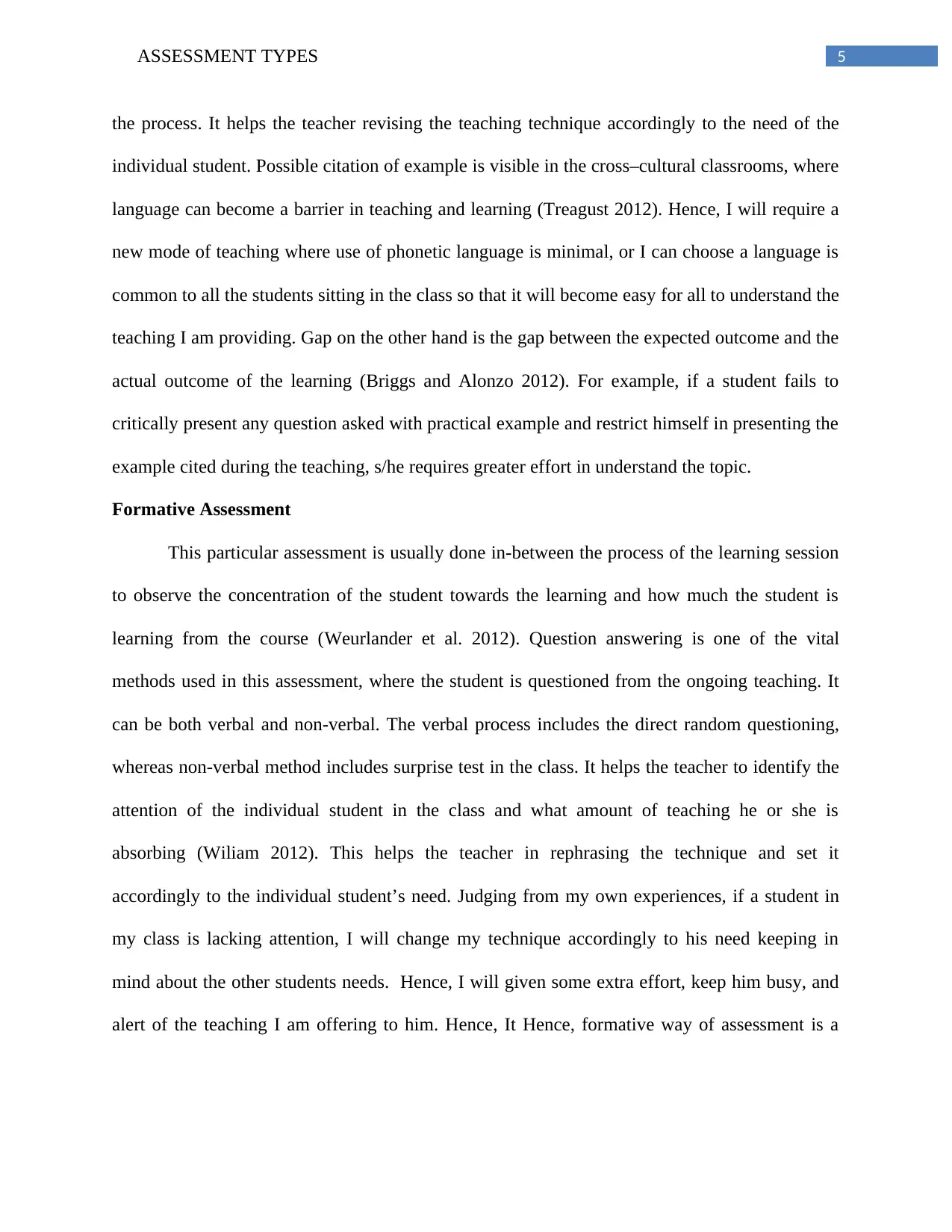
5ASSESSMENT TYPES
the process. It helps the teacher revising the teaching technique accordingly to the need of the
individual student. Possible citation of example is visible in the cross–cultural classrooms, where
language can become a barrier in teaching and learning (Treagust 2012). Hence, I will require a
new mode of teaching where use of phonetic language is minimal, or I can choose a language is
common to all the students sitting in the class so that it will become easy for all to understand the
teaching I am providing. Gap on the other hand is the gap between the expected outcome and the
actual outcome of the learning (Briggs and Alonzo 2012). For example, if a student fails to
critically present any question asked with practical example and restrict himself in presenting the
example cited during the teaching, s/he requires greater effort in understand the topic.
Formative Assessment
This particular assessment is usually done in-between the process of the learning session
to observe the concentration of the student towards the learning and how much the student is
learning from the course (Weurlander et al. 2012). Question answering is one of the vital
methods used in this assessment, where the student is questioned from the ongoing teaching. It
can be both verbal and non-verbal. The verbal process includes the direct random questioning,
whereas non-verbal method includes surprise test in the class. It helps the teacher to identify the
attention of the individual student in the class and what amount of teaching he or she is
absorbing (Wiliam 2012). This helps the teacher in rephrasing the technique and set it
accordingly to the individual student’s need. Judging from my own experiences, if a student in
my class is lacking attention, I will change my technique accordingly to his need keeping in
mind about the other students needs. Hence, I will given some extra effort, keep him busy, and
alert of the teaching I am offering to him. Hence, It Hence, formative way of assessment is a
the process. It helps the teacher revising the teaching technique accordingly to the need of the
individual student. Possible citation of example is visible in the cross–cultural classrooms, where
language can become a barrier in teaching and learning (Treagust 2012). Hence, I will require a
new mode of teaching where use of phonetic language is minimal, or I can choose a language is
common to all the students sitting in the class so that it will become easy for all to understand the
teaching I am providing. Gap on the other hand is the gap between the expected outcome and the
actual outcome of the learning (Briggs and Alonzo 2012). For example, if a student fails to
critically present any question asked with practical example and restrict himself in presenting the
example cited during the teaching, s/he requires greater effort in understand the topic.
Formative Assessment
This particular assessment is usually done in-between the process of the learning session
to observe the concentration of the student towards the learning and how much the student is
learning from the course (Weurlander et al. 2012). Question answering is one of the vital
methods used in this assessment, where the student is questioned from the ongoing teaching. It
can be both verbal and non-verbal. The verbal process includes the direct random questioning,
whereas non-verbal method includes surprise test in the class. It helps the teacher to identify the
attention of the individual student in the class and what amount of teaching he or she is
absorbing (Wiliam 2012). This helps the teacher in rephrasing the technique and set it
accordingly to the individual student’s need. Judging from my own experiences, if a student in
my class is lacking attention, I will change my technique accordingly to his need keeping in
mind about the other students needs. Hence, I will given some extra effort, keep him busy, and
alert of the teaching I am offering to him. Hence, It Hence, formative way of assessment is a
⊘ This is a preview!⊘
Do you want full access?
Subscribe today to unlock all pages.

Trusted by 1+ million students worldwide
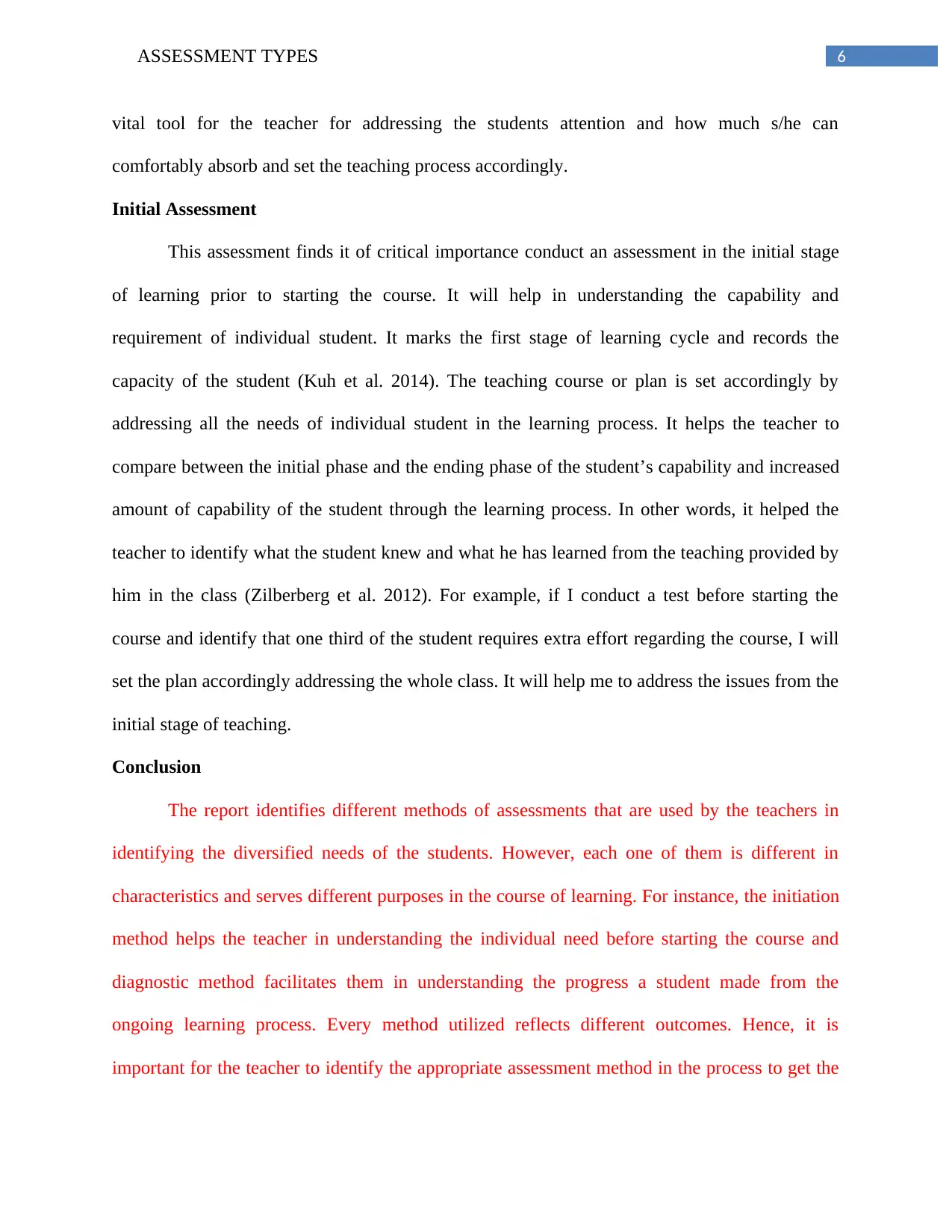
6ASSESSMENT TYPES
vital tool for the teacher for addressing the students attention and how much s/he can
comfortably absorb and set the teaching process accordingly.
Initial Assessment
This assessment finds it of critical importance conduct an assessment in the initial stage
of learning prior to starting the course. It will help in understanding the capability and
requirement of individual student. It marks the first stage of learning cycle and records the
capacity of the student (Kuh et al. 2014). The teaching course or plan is set accordingly by
addressing all the needs of individual student in the learning process. It helps the teacher to
compare between the initial phase and the ending phase of the student’s capability and increased
amount of capability of the student through the learning process. In other words, it helped the
teacher to identify what the student knew and what he has learned from the teaching provided by
him in the class (Zilberberg et al. 2012). For example, if I conduct a test before starting the
course and identify that one third of the student requires extra effort regarding the course, I will
set the plan accordingly addressing the whole class. It will help me to address the issues from the
initial stage of teaching.
Conclusion
The report identifies different methods of assessments that are used by the teachers in
identifying the diversified needs of the students. However, each one of them is different in
characteristics and serves different purposes in the course of learning. For instance, the initiation
method helps the teacher in understanding the individual need before starting the course and
diagnostic method facilitates them in understanding the progress a student made from the
ongoing learning process. Every method utilized reflects different outcomes. Hence, it is
important for the teacher to identify the appropriate assessment method in the process to get the
vital tool for the teacher for addressing the students attention and how much s/he can
comfortably absorb and set the teaching process accordingly.
Initial Assessment
This assessment finds it of critical importance conduct an assessment in the initial stage
of learning prior to starting the course. It will help in understanding the capability and
requirement of individual student. It marks the first stage of learning cycle and records the
capacity of the student (Kuh et al. 2014). The teaching course or plan is set accordingly by
addressing all the needs of individual student in the learning process. It helps the teacher to
compare between the initial phase and the ending phase of the student’s capability and increased
amount of capability of the student through the learning process. In other words, it helped the
teacher to identify what the student knew and what he has learned from the teaching provided by
him in the class (Zilberberg et al. 2012). For example, if I conduct a test before starting the
course and identify that one third of the student requires extra effort regarding the course, I will
set the plan accordingly addressing the whole class. It will help me to address the issues from the
initial stage of teaching.
Conclusion
The report identifies different methods of assessments that are used by the teachers in
identifying the diversified needs of the students. However, each one of them is different in
characteristics and serves different purposes in the course of learning. For instance, the initiation
method helps the teacher in understanding the individual need before starting the course and
diagnostic method facilitates them in understanding the progress a student made from the
ongoing learning process. Every method utilized reflects different outcomes. Hence, it is
important for the teacher to identify the appropriate assessment method in the process to get the
Paraphrase This Document
Need a fresh take? Get an instant paraphrase of this document with our AI Paraphraser

7ASSESSMENT TYPES
desired result. The assessment processes utilized for the learning sessions will prove its worth as
these methods are set according to the purpose they need to serve.
desired result. The assessment processes utilized for the learning sessions will prove its worth as
these methods are set according to the purpose they need to serve.
1 out of 8
Related Documents
Your All-in-One AI-Powered Toolkit for Academic Success.
+13062052269
info@desklib.com
Available 24*7 on WhatsApp / Email
![[object Object]](/_next/static/media/star-bottom.7253800d.svg)
Unlock your academic potential
Copyright © 2020–2025 A2Z Services. All Rights Reserved. Developed and managed by ZUCOL.




